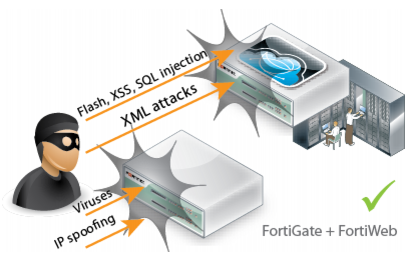Planning the network topology
To receive traffic intended for web servers that your FortiWeb appliance will protect, you usually must install the FortiWeb appliance between the web servers and all clients that access them.
The network configuration should make sure that all network traffic destined for the web servers must first pass to or through the FortiWeb appliance (depending on your operation mode). Usually, clients access web servers from the Internet through a firewall such as a FortiGate, so the FortiWeb appliance should be installed between the web servers and the firewall.

| Install a general purpose firewall such as FortiGate in addition to the FortiWeb appliance. Failure to do so could leave your web servers vulnerable to attacks that are not HTTP/HTTPS-based. FortiWeb appliances are not general-purpose firewalls, and, if you enable IP-based forwarding, will allow non-HTTP/HTTPS traffic to pass through without inspection. Ideally, control and protection measures should only allow web traffic to reach FortiWeb and your web servers. FortiWeb and FortiGate complement each other to improve security. |
Other topology details and features vary by the mode in which the FortiWeb appliance will operate. For example, FortiWeb appliances operating in offline protection mode or either of the transparent modes cannot do network address translation (NAT) or load-balancing; FortiWeb appliances operating in reverse proxy mode can.

